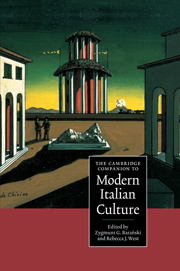Book contents
- Frontmatter
- Introducing modern Italian culture
- 1 The notion of Italy
- 2 Social and political cultures in Italy from 1860 to the present day
- 3 Questions of language
- 4 Intellectuals, culture and power in modern Italy
- 5 Catholicism
- 6 Socialism, Communism and other ‘isms’
- 7 Other voices: contesting the status quo
- 8 Narratives of self and society
- 9 Searching for new languages: modern Italian poetry
- 10 Drama: realism, identity and reality on stage
- 11 Italian cinema
- 12 Art in modern Italy: from the Macchiaioli to the Transavanguardia
- 13 A modern identity for a new nation: design in Italy since 1860
- 14 Fashion: narration and nation
- 15 The media
- 16 Since Verdi: Italian serious music 1860-1995
- 17 Folk music and popular song from the nineteenth century to the 1990s
- 18 Epilogue: Italian culture or multiculture in the new millennium?
- Index
- Series List
1 - The notion of Italy
Published online by Cambridge University Press: 28 May 2006
- Frontmatter
- Introducing modern Italian culture
- 1 The notion of Italy
- 2 Social and political cultures in Italy from 1860 to the present day
- 3 Questions of language
- 4 Intellectuals, culture and power in modern Italy
- 5 Catholicism
- 6 Socialism, Communism and other ‘isms’
- 7 Other voices: contesting the status quo
- 8 Narratives of self and society
- 9 Searching for new languages: modern Italian poetry
- 10 Drama: realism, identity and reality on stage
- 11 Italian cinema
- 12 Art in modern Italy: from the Macchiaioli to the Transavanguardia
- 13 A modern identity for a new nation: design in Italy since 1860
- 14 Fashion: narration and nation
- 15 The media
- 16 Since Verdi: Italian serious music 1860-1995
- 17 Folk music and popular song from the nineteenth century to the 1990s
- 18 Epilogue: Italian culture or multiculture in the new millennium?
- Index
- Series List
Summary
Introduction
Of what is one writing when one writes a history of Italy? What, if any, is the thread of continuity that allows us to mean the same thing when we refer to Italy at the fall of the Roman Empire, the death of Dante, the French invasions of 1494 or 1796, the Congress of Vienna, unification, the end of the First World War, the fall of Fascism, or the 1994 election? The first aim of this essay is to argue that there is no single thread of continuity, no common plane of analysis of Italian history. When we examine two of the elements that might serve as that thread or plane, geographical space and culture, what we find is that the historiographical utility of the concept of Italy has to be demonstrated rather than assumed. Italy has to be constructed; it is not given to us directly by the historical sources. My second aim is to show that the notion of Italy is an important dimension of Italian history itself. Using examples from the postunification era, I will suggest some of the ways in which varying notions of Italy have informed and been influenced by the key problem of nation- and state-formation.
- Type
- Chapter
- Information
- The Cambridge Companion to Modern Italian Culture , pp. 17 - 34Publisher: Cambridge University PressPrint publication year: 2001
- 8
- Cited by



